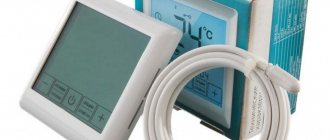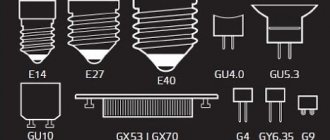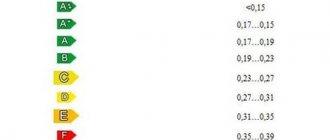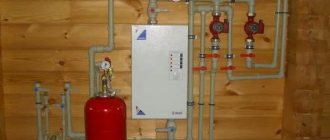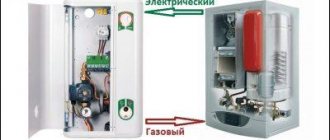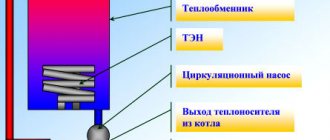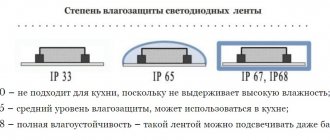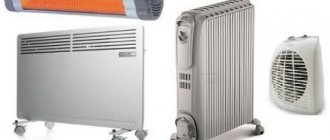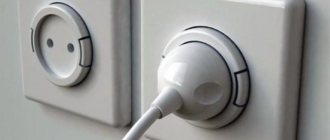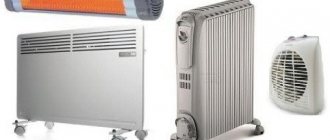It is impossible to determine the exact consumption of an electric boiler, since it depends both on weather conditions, the location and parameters of the house, as well as on operating conditions and the functionality of the automation. However, calculating an approximate figure and presenting the approximate amount to pay for heating a private house with an electric boiler is quite simple. At the same time, not everyone knows that energy consumption can be reduced by 10, 30, and sometimes even 50% by resorting to small, quickly recouping costs, which are described in detail in this article.
Methods for determining the electricity consumption of household appliances and tools
The average electricity consumption in citizens' apartments per month is the sum of the total electricity consumption of all electrical appliances used by its residents.
Knowing the electricity consumption for each of them will give an understanding of how rationally they are used. Changing the operating mode can provide significant energy savings. The total amount of electricity consumed per month in an apartment or house is recorded by the meter. There are several ways to obtain data for individual devices.
A practical way to calculate electricity consumption based on the power of an electrical appliance
The average daily electricity consumption of any home appliance is calculated using the formula; just remember the basic characteristics of electrical appliances. These are three parameters - current, power and voltage. Current is expressed in amperes (A), power in watts (W) or kilowatts (kW), and voltage in volts (V). From the school physics course, we remember how electricity is measured - it is a kilowatt-hour, it means the amount of electricity consumed per hour. All home appliances are equipped with labels on the cable or on the device itself, which indicate the input voltage and current consumption (for example, 220 V 1 A). The same data must be present in the product passport. Based on current and voltage, the power consumption of the device is calculated - P=U×I, where
- P – power (W)
- U – voltage (V)
- I – current (A).
We substitute the numerical values and get 220 V × 1 A = 220 W.
Next, knowing the power of the device, we calculate its energy consumption per unit of time. For example, a regular liter electric kettle has a power of 1600 W. On average, he works 30 minutes a day, that is, ½ hour. We multiply the power by the operating time and get:
1600 W × 1/2 hour = 800 W/h, or 0.8 kW/h.
To calculate costs in monetary terms, we multiply the resulting figure by the tariff, for example, 4 rubles per kWh:
0.8 kW/h×4 rub.=3.2 rub. Calculation of the average monthly fee - 3.2 rubles * 30 days = 90.6 rubles.
In this way, calculations are made for each electrical appliance in the house.
Counting electricity consumption using a wattmeter
The calculations will give you an approximate result. It is much more reliable to use a household wattmeter, or energy meter - a device that measures the exact amount of energy consumed by any household device.
Digital wattmeter
Its functions:
- measuring power consumption at a given moment and over a certain period of time;
- current and voltage measurement;
- calculation of the cost of consumed electricity according to the tariffs you have set.
The wattmeter is plugged into a socket and the device you are going to test is connected to it. The display shows power consumption parameters.
Current clamps allow you to measure the current and determine the power consumed by a household appliance without disconnecting it from the network. Any device (regardless of manufacturer and modification) consists of a magnetic circuit with a movable disconnect bracket, a display, a voltage range switch and a button for recording readings.
Measurement procedure:
- Set the desired measuring range.
- Open the magnetic circuit by pressing the bracket, place it behind the wire of the device under test and close it. The magnetic core must be located perpendicular to the power wire.
- Take readings from the screen.
If a multi-core cable is placed in the magnetic core, the display will show zero. This happens because the magnetic fields of two conductors carrying the same current cancel each other out. To obtain the required values, measurements are carried out on only one wire. It is convenient to measure energy consumption through an extension cord-adapter, where the cable is divided into separate cores.
Determining energy consumption using an electric meter
A meter is another simple way to determine the power of a household appliance.
How to count light using a meter:
- Turn off everything in the apartment that runs on electricity.
- Record your readings.
- Plug in the desired device for 1 hour.
- Disable it and subtract the previous readings from the received numbers.
The resulting number will be an indicator of the electricity consumption of the individual device.
Buying Tips
When choosing an electric boiler for heating a private home, you should pay attention not only to reviews and electricity consumption, but also to other parameters. 1. Installation method
In an apartment or small private house, it is optimal to install a wall-mounted boiler. They look aesthetically pleasing, fit neatly into the interior of the home, and at the same time are capable of producing significant temperatures. As for floor-standing options, they can be classified as industrial or semi-industrial models. These are units for large households with a power of 24 kW
Installation method. In an apartment or small private house, it is optimal to install a wall-mounted boiler. They look aesthetically pleasing, fit neatly into the interior of the home, and at the same time are capable of producing significant temperatures. As for floor-standing options, they can be classified as industrial or semi-industrial models. These are units for large households with a power of 24 kW
1. Installation method. In an apartment or small private house, it is optimal to install a wall-mounted boiler. They look aesthetically pleasing, fit neatly into the interior of the home, and at the same time are capable of producing significant temperatures. As for floor-standing options, they can be classified as industrial or semi-industrial models. These are units for large households with a power of 24 kW.
2. Method of connection to the electrical network. Economical low-performance electric boilers are plugged into a regular 220 V outlet. But for units of medium or high power, it will be necessary to install a three-phase 380 V network. A regular 220 V network will not support such a load.
3. Number of connections. Here is the standard classification: single-circuit and double-circuit models. The former are exclusively for heating, the latter, in addition to this, also heat water for the water supply.
4. And yet the main indicator is productivity. It determines the energy consumption and heating area. Standard minimum – 100 W per square meter
Please pay attention to this point: the worse the thermal insulation of your home, the more powerful the boiler you will have to buy, and, accordingly, the more you will pay for electricity later
A few more landmarks. The current should be limited to a maximum of 40 A. Electric boiler pipes are 1 ½″ or more. Pressure – up to 3-6 atmospheres. A power control function is required - at least 2-3 steps.
Be sure to inquire about the quality indicators of the local power supply - if the voltage drops to 180 V in the evenings, the imported model will not even turn on.
Before buying an electric boiler for 10-15 kW or higher, find out whether the transformer from which the house is powered will handle it. Otherwise you will have to lay an additional line to your estate.
As for specific models, the most popular are imported ones, since they provide high performance with minimal power. Among the most popular, according to sellers' reviews, are:
- wall-mounted, single-circuit Tenko KEM, 3.0 kW/220V, cost around $45-55;
- wall-mounted, single-circuit UNIMAX 4.5/220, cost $125-200;
- wall-mounted, single-circuit Ferroli LEB 12, 12 kW, price – $350-550;
- wall-mounted, single-circuit Protherm Skat 9K, 9 kW, cost $510-560.
How to calculate how much electricity an electric heating boiler consumes
It is impossible to determine the exact consumption of an electric boiler, since it depends both on weather conditions, the location and parameters of the house, as well as on operating conditions and the functionality of the automation.
However, calculating an approximate figure and presenting the approximate amount to pay for heating a private house with an electric boiler is quite simple.
At the same time, not everyone knows that energy consumption can be reduced by 10, 30, and sometimes even 50% by resorting to small, quickly recouping costs, which are described in detail in this article.
We calculate how much electricity an electric boiler consumes per hour, day and month
Almost all modern electric boilers have an efficiency of 99% or more. This means that at maximum load a 12 kW electric boiler will consume 12.12 kW of electricity. Electric boiler with a heating capacity of 9 kW - 9.091 kW of electricity per hour. Total, the maximum possible consumption of a 9 kW boiler:
- Per day – 24 (hours) * 9.091 (kW) = 218.2 kW. In value terms, with the current tariff for the Moscow region at the end of 2022 – 218.2 (kW) * 5.56 (rubles per 1 kWh) = 1,213.2 rubles / day.
- The electric boiler consumes 30 (days) per month * 2.18.2 (kW) = 6,546 kW. In value terms – 36,395.8 rubles/month.
- For the heating season (suppose from October 15 to March 31) – 136 (days) * 218.2 (kW) = 29,675.2 kW. In value terms – 164,994.1 rubles/season.
However, a boiler unit correctly selected for power never operates at maximum load 24/7.
On average, during the heating season, an electric boiler consumes about 40-70% of the maximum power, that is, it works only 9-16 hours a day.
So, in practice, in an average brick house of 70-80 m2 in the climatic zone of the Moscow region, the same 9 kW boiler requires a consumption of 13-16 thousand rubles per month.
Consumption based on house parameters
A visual representation of heat loss in a private home.
You can more accurately estimate the possible power consumption of an electric boiler by knowing the parameters of the house and its heat losses (also measured in kW).
To maintain a comfortable temperature, heating equipment must replenish heat loss in the home.
This means that the heating output of the boiler = the heat loss of the house, and since the efficiency of electric boilers is 99% or more, then, roughly, the heating output of the electric boiler is also equal to the electricity consumption. That is, the heat loss of the house approximately reflects the consumption of the electric boiler.
| Heat loss of typical residential buildings with an area of 100 m2 | ||
| Coating type and thickness | Average heat loss, kW (per hour) | Peak heat loss at -25°С, kW (per hour) |
| Frame insulated with mineral wool (150 mm) | 3,4 | 6,3 |
| Foam block D500 (400 mm) | 3,7 | 6,9 |
| House according to SNiP Mos. region | 4 | 7,5 |
| Foam concrete D800 (400 mm) | 5,5 | 10,2 |
| Hollow brick (600 mm) | 6 | 11 |
| Log (220 mm) | 6,5 | 11,9 |
| Beam (150 mm) | 6,7 | 12,1 |
| Frame insulated with mineral wool (50 mm) | 9,1 | 17,3 |
| Reinforced concrete (600 mm) | 14 | 25,5 |
The two best ways to reduce electric boiler consumption
How to choose an external thermostat for an electric boiler and save up to 30% on heating every month
If the automation does not provide the ability to program the operating mode, you can seriously reduce the energy consumption of the boiler by connecting a programmable room thermostat to it (if there are appropriate contacts, information about the possibility of connecting external control is always indicated in the technical specifications).
A programmable room thermostat controls the operation of the boiler based on measurements of the air temperature in the room in which it is installed, and not on the temperature of the coolant. However, the main and most important task for saving purposes is the programming mode of work settings for the next day and week. For example, during working hours when the owners are away from home, you can set the temperature to 15°C. And during sleep – 18 or 19°C. Such parameters will not affect comfort, but will significantly reduce the final energy consumption.
The second indispensable element when heating with an electric boiler is an electric meter, which differentiates electricity consumption by two, or better yet, by three time zones. For example, for the Moscow region the following tariffs are differentiated by time zones:
- peak zone (from 7:00 to 10:00 and from 17:00 to 21:00) – 5.06 rubles per 1 kWh;
- half-peak zone (from 10:00 to 17:00 and from 21:00 to 23:00) – 3.89 rubles per 1 kWh;
- night zone (from 23:00 to 7:00) – 1.68 rubles per 1 kWh.
In practice, the costs of purchasing, designing and installing a metering device that differentiates consumption pays off in a few months, since it reduces costs in monetary terms by 15-25%.
Instructions BoilersWays to save Electric boilers
How to reduce electrical energy costs
Now you have found out how many kilowatts an electric boiler consumes and, perhaps, have made your calculations. It will be useful to learn about methods and techniques for reducing energy consumption at the calculation stage:
- Improving the work on temperature changes allows you to avoid temperature fluctuations in rooms with different purposes and reduces energy consumption. For this purpose, room thermostats are used. They allow the owner to reduce or increase the heating power at any time. The amount of energy consumed depends largely on the temperature outside. Naturally, the lower the air temperature outside the window, the greater the consumption.
- The results of calculating consumption and cost are influenced by the type of accounting and the use of a mixed heating method. It is clear that the daily distribution of loads between energy consumers is different. As a result, in order to maintain the required temperature, it is logical for the boiler to operate at night (from 23.00 to 6.00), that is, when energy consumption begins at a minimum and at other rates.
- Multi-tariff accounting makes it possible to save about a third of financial costs.
- It is possible to achieve better performance in the operation of the boiler by using pressure circulation equipment. The pump is mounted in the return network and minimally limits the period of contact of the walls of the heating unit with the hot coolant. Therefore, the use of the generated heat source becomes longer.
- You can save money on electricity costs by adding a device for obtaining heat from other raw materials to a functioning boiler. In addition, this will reduce the consumption of gas, fuel oil, coal or other selected energy source.
Therefore, the energy consumption of the boiler can be optimized. But you need to put effort into this.
Electric boilers effectively cope with the task - they provide warmth and comfort in the house, work efficiently and are durable. As for maintaining this device, it is an expensive pleasure. But in some conditions it is impossible to use another version of the heating system. Therefore, an electric boiler becomes a real salvation.
Scheme 2: according to housing characteristics
An electric boiler does not always exactly match the heating energy needs of a home. Often its power is selected with a reserve. Here are some examples of such scenarios:
A dual-circuit device provides the house with hot water;
The power of a double-circuit boiler is excessive, since it must provide the house with hot water. Including during the heating season.
- It is planned to add additional rooms to the house with the connection of heating devices in them to the existing circuit;
- The region is characterized by rare but severe frosts, and the heating system is designed specifically for them.
The photo shows winter Sevastopol. Even in warm regions there are severe frosts. The heating system has to be designed with a safety margin.
If the boiler power is obviously excessive, you will have to focus not on it, but on the actual heat consumption of the house. Most accurately, it can be calculated using the formula Q=V*Dt*k/860.
The variables in this formula from left to right are:
- Energy consumption (kW);
- The volume of the room that needs to be heated. It is indicated in SI units - cubic meters;
The volume of a room is equal to the product of its three dimensions.
- Difference between indoor and outdoor temperatures;
- Insulation coefficient.
Where do I get the last two parameters?
The temperature delta is taken equal to the difference between the sanitary norm for the room and the coldest five days of winter.
You can take sanitary standards for residential premises from this table:
| Description | Temperature norm, C |
| A room in the center of the house, the lowest winter temperature is above -31C | 18 |
| A room in the center of the house, the lowest winter temperature is below -31C | 20 |
| Corner or end room, lower winter temperature above -31C | 20 |
| Corner or end room, lower winter temperature below -31C | 22 |
Sanitary temperature standards for non-residential rooms and common areas.
And here is the temperature of the coldest five-day period for some cities of our great and vast:
| City | Value, C |
| Khabarovsk | -29 |
| Surgut | -43 |
| Smolensk | -25 |
| Saint Petersburg | -24 |
| Saratov | -25 |
| Petrozavodsk | -28 |
| Permian | -25 |
| Eagle | -25 |
| Omsk | -37 |
| Novosibirsk | -37 |
| Murmansk | -30 |
| Moscow | -25 |
| Magadan | -29 |
| Kemerovo | -39 |
| Kazan | -31 |
| Irkutsk | -33 |
| Ekaterinburg | -32 |
| Volgograd | -22 |
| Vladivostok | -23 |
| Vladimir | -28 |
| Verkhoyansk | -58 |
| Bryansk | -24 |
| Barnaul | -36 |
| Astrakhan | -21 |
| Arkhangelsk | -33 |
Distribution of winter temperatures across Russia.
The insulation coefficient can be selected from the following range of values:
- A house with an insulated facade and triple glazing - 0.6-0.9;
- Two-brick walls without insulation and double-glazed windows - 1-1.9;
- Brick walls and single-strand glazed windows - 2 - 2.9.
Example
Let's calculate the electricity consumption for heating with our own hands for a month for the following conditions:
House size: 6x8x3 meters.
Climatic zone: Sevastopol, Crimea peninsula (the temperature of the coldest five-day period is -11C).
Insulation: single glass with high thermal conductivity, walls made of rubble stone half a meter thick.
A rubble house with single glazing requires intense heating in winter.
| We calculate the volume. 8*6*3=144 m3. |
| We calculate the temperature difference. The sanitary standard for a private house (warm region, all rooms are at the end or corner) is 20C, the temperature of the coldest five days of winter is -11. Delta - 20 - -11 = 33C. |
| We select the insulation coefficient. Thick walls made of rubble stone with its high thermal conductivity and single glazing give its value around 2.0. |
| Substitute the values into the formula. Q=144*33*2/860=11 (rounded) kilowatt. |
We also went through the technique of further calculations:
- The boiler will consume an average of 5.5*24=132 kWh per day;
- It will consume 132*30=3960 kilowatt-hours of electricity per month.
Switching to a two-tariff meter will allow you to slightly reduce heating costs.
Given
First, a few general notes to help you understand the proposed schemes:
- Part of the time the boiler is idle or operates at reduced power. Its rated power is selected to match the peak energy consumption of the house, which occurs on the coldest days of winter. When the thermometer rises, the need for heat decreases;
During the thaw, the home's need for heat decreases.
Thermal energy consumption, with constant thermal conductivity of the walls, is directly proportional to the temperature difference between the house and the street. It will decrease not only when the outside temperature increases, but also when the internal temperature decreases.
- The efficiency (coefficient of performance) of any electric heating device with a minimum error is 100% and does not depend on the type of heating element. The small amount of heat that is dissipated by the body of the device also goes to heating the house;
To reduce non-target heat losses, the boiler heat exchanger is insulated with mineral wool or teplovol (foil insulation based on heat-resistant foamed polymer).
Therefore, the thermal power of a boiler is always taken equal to its electrical power: a device that consumes 8 kilowatts of electricity will give off the same amount of heat.
- The average actual consumption of a boiler with correctly calculated power is approximately equal to half the consumption at rated power for the same time. Simply put, an 8-kilowatt appliance consumes 4 kilowatts on average during the winter months.
Having heated the water to the desired temperature, the boiler turns off the heating and waits for the coolant to cool.
How to find out how many kilowatts per day a gas appliance consumes
To find out how much electricity a gas boiler consumes, you need to do a regular calculation of energy consumption - it is used for any electrical appliances.
For the calculation, you will need the value of the electrical power of the boiler. Its value is indicated in the technical documentation; it is measured in watts (W or W) and kilowatts. Usually they indicate the maximum value of kilowatts consumed by the device - it significantly exceeds the average.
Let's say we have a Baxi Eco Four 24 double-circuit heater, its heating capacity is 24 kW, and its electric capacity is 130 W. To calculate daily electricity consumption, you need to multiply the power consumption by the number of hours during which consumption occurs.
If energy is consumed around the clock: 130 W x 24 hours = 3120 Wh
This is the maximum consumption of the Baxi Eco Four 24 model per day. Dividing the result by 1000, we get 3.12 kWh. To find out how many kWh the device consumes per month - and it is in these units that the consumed electrical power is indicated in payment receipts - you need to multiply the number of kilowatts consumed per day by 30:
3.12 kWh x 30 (days) = 93.6 kWh
This is the maximum value of consumed electrical power. It is clear that to calculate consumption for a year, you need to multiply the result by the number of months in a year during which the device operates.
For single-circuit models, their number is limited by the heating season - about 5. For dual-circuit devices switched to economical summer mode, consumption is calculated taking into account the summer months.
What is electricity used for?
In heating equipment connected to electrical networks, the lion's share of electricity is consumed:
- Circulation pump. It “eats” electricity more than others and consumes energy up to 200 watts per hour. Like any electric motor, the pump requires impeccable voltage parameters. Any non-compliance with the standards leads to a decrease in power indicators - it begins to work noisily and may even break down.
- Protective automation. It consumes little electricity - about 15-30 W. He is afraid of changes in the power supply - because of them, the controller may break, which will cause the equipment to turn off.
- Burners. They are extremely demanding on current characteristics. They require a three-pole connection so that the fire is recognized by the ionization electrode and the burner does not stop operating. Gas burner devices are characterized by a long starting current of the fan - the starting power increases. The fan motor is sensitive to the parameters of the electrical network - even with the smallest deviations from the correct sinusoid, it operates unstable.
What determines the amount of energy consumed?
From an economic point of view, electric models are better installed in small houses. But in order to determine how much you will have to pay for the energy consumed, it is necessary to calculate the heat loss of the building, taking into account:
- Total area
- Ceiling height
- Material of walls and ceilings
- Number of windows
In this case, the inertial heating system wins; the boiler included in it does not operate constantly, but at certain intervals.
All kinds of electronic devices can also reduce electricity consumption:
- Room thermostat
- Control device
- Programmable sensor
They allow you to reduce or increase the heating intensity at certain hours. The amount of energy consumed also depends on the outside temperature; at lower temperatures they will be the highest.
There are two options that you can use when choosing boiler power. The first is approximate, it is calculated taking into account the fact that the building has excellent thermal insulation, then 1 kW of boiler power is taken per 10 m².
Of the three existing models of electric boilers, the most widespread are cathode and heating element boilers. Of these, ionic ones are considered the most economical. Their efficiency reaches 98%, so the use of such models in a two-pipe heating system will give an economic effect of at least 35%, compared to other electrical devices.
Achieving such results is possible not only because of the method of energy transfer, but also because of the entire operating principle of the device. In a heating system that is configured correctly, the cathode apparatus starts working with less than 50% power.
How much electricity does an electric boiler consume?
There are many types of units that are used to heat houses: for example, if the operating principle of the device is the combustion of various fuels, then it combines several functions:
- Energy conversion.
- Energy generation.
Electric boilers do not have the function of generating energy, they only convert it from electricity to heat. And this significantly increases their coefficient of performance (efficiency).
The cost of such equipment depends on several components:
- Where the housing is located.
- Do people permanently live in this premises?
To correctly select the unit that will heat the room, it is necessary to take into account some conditions:
- The cost of the heating device.
- Costs for the purchase of radiators, convectors, pipelines, etc.
- Additional costs for installation of this equipment.
- Expenses for documentation and connection to electrical networks.
When choosing a heating unit, many homeowners prefer electric boilers. Compared to other types of devices, they have high performance and a wide range of heating - from small houses to cottages with a large area. No matter how hard you try, you can’t do without some calculations when choosing this device.
It is necessary to decide how many circuits should be on this equipment. If this is a double-circuit unit, then you need to decide how it will be used - only for heating the room or also for heating water.
After completing these formalities, you need to decide on some more parameters:
- The choice of device depends on the area of the heated room.
- What voltage is available to connect the device to the mains.
- Duration of the heating season.
- Is heating constantly needed in winter (in what month are residents expected to stay in a heated room).
- How long will the heating unit operate at maximum load?
- Its performance and efficiency.
- Electricity consumption per month.
How much electricity does an electric boiler consume?
If we consider the average statistical indicators, at which the electricity consumption of the device is considered approximately, then the calculation is as follows: to heat a house with an area of 50 square meters. m, a device with a power of 3 kW will need 0.7 kW/hour, so in a day with continuous operation it can consume 16.8 kW/hour.
Some details in examples
It is also necessary to take into account the cable cross-section, especially if high-power electric boilers are connected. The cut area of current-carrying conductors for single-phase units is determined by an elementary formula, which is perceived as an axiom. Section in sq. mm must be no less than the rated power, which characterizes the performance and consumption of the electric boiler and expressed in kW
With three-phase power supply, the calculation is more complicated and it is important not to forget that electricity consumption by an electric boiler over 10 kW requires registration of permits for the selection of this load from the electrical network
Selecting a heating boiler
There are 3 types of electric boilers, the efficiency of which ranges from 90 to 98%. Regardless of the type, there are single-circuit and double-circuit boilers, so if hot water supply is needed, then you should choose a double-circuit one.
heating elements new
This is the “oldest” type of electric boiler, working on the principle of an electric kettle. The only difference is that water circulates in the system constantly, passing through the heating chamber where the heating elements are located. The model is characterized by an efficiency of 90-95%, but non-freezing liquid can be used as a coolant, which is convenient for a summer residence. The device has small dimensions and a respectable appearance.
Induction
Here the coolant is heated by passing through a pipe located inside the inductor. The inductor itself is not a heater, that is, it is a winding through which alternating electric current passes. As a result, an alternating magnetic field arises, which induces Foucault eddy currents in the metal pipe, and the eddy currents heat the pipe according to Joule Lenz's law.
This type is characterized by high efficiency - up to 98%, electrical safety and reliability. The disadvantages were large dimensions and high price.
Electrode
This is a relatively new type of heating technology, which today attracts with its low price, high efficiency - 98% and small dimensions. The principle of operation is quite simple. There are 2 electrodes inside and current flows through the coolant - water, and it heats up.
What are the types
Before purchasing a particular model of heating equipment, you need to know all its features.
Manufacturers produce three types of such products:
- heating elements new
- Cathode
- Film
They differ in the method of heating the coolant and the amount of energy consumed.
Heating elements heat water using a spiral placed in a sealed copper tube that has terminals for connecting to the electrical network. The current heats the coil, and from it the heat is transferred to the water or antifreeze located in the boiler.
In cathode systems, heating of the coolant is carried out in the process of its ionization or passing alternating current through it.
Film samples - have an operating principle based on the use of infrared rays.
How to calculate your TV's electricity consumption
A TV is an essential element of household appliances in every home. Often, owners install several copies for each room. Devices can be of several types: cathode ray tube models, LED, LSD or plasma TVs. The power consumption of a device is affected by its type, screen size, color, brightness, white and black balance, active operation time, and duration of sleep mode. Based on the table of electricity consumption by household appliances, a TV uses an average of 0.1-0.3 kW.
Electrical energy consumption will depend on the type and operating mode of the TV.
The power of TVs in Watts with a cathode ray tube is 60-100 W per hour. On average he can work about 5 hours a day. Monthly consumption reaches 15 kW. This is how much electricity will be spent on its active operation. The TV also consumes 2-3 watts per hour in standby mode when plugged in. Total energy consumption can be 16.5-17.5 kW per month.
The energy consumption of LED or LSD models directly depends on the screen size. For example, an LSD TV with a 32-inch screen diagonal will consume 45-55 W per hour in operating mode, and 1 W in standby mode. The total electricity consumption per month is 6.7-9 kW. LED models consume on average 35-40% less electrical energy. In active mode, a 42-inch TV will use 80-100 W, in sleep mode - 0.3 W. Total consumption per month will be 15-20 kW.
Plasma TVs have good color reproduction. The TV power in kW is 0.15-0.19 in active mode, and 120 W/day in sleep mode. The total consumption per month can be 30-35 kW. To save energy, you should remove the plug from the socket, correctly adjust the brightness level depending on the time of day, and set the timer to automatically turn off.
How much electricity can household electrical appliances consume?
1. Computer
Calculations that will show how much electricity a computer consumes will be carried out approximately, since everything depends on the power of your computer’s power supply and the specific work that the computer is performing at the moment.
For example, if the power of a computer unit is from 350 to 550 Watts, it is unlikely to consume all the power even under full load. It is also necessary to take into account the monitor - from 60 to 100 watts. In total, with an average computer power supply of 450 Watts and a monitor of 100 Watts, you get 550 Watts or 0.55 kW of electricity per hour. This figure is greatly overestimated. For an approximate calculation, you can take the maximum value - 0.5 kW/h. Thus, when using a computer 4 hours a day, the result is 60 kW/h per month. (0.5*4*30). Now you can build on these numbers, for example, when using a computer 8 hours a day, we get 120 kW/h. per month.
2. Refrigerator
The technical data sheet for the refrigerator indicates the annual electricity consumption. Basically, this figure ranges from 230 to 450 kW/h. Dividing this value by 12, we get from 20 to 38 kW/h of electricity consumption per month. This indicator is applicable only for ideal conditions. The amount of power consumed depends on the volume of the refrigerator and the number of products in it. It is also necessary to take into account external conditions depending on the time of year.
3. TV
TVs are different. On average, for calculation, we will take 100 Wh. For example, when watching TV you spend 5 hours a day - 0.5 kWh. Per month - about 15 kW/h. LCD TVs with large screen diagonals consume 200-50 W per hour. Screen brightness also plays an important role. Accordingly, we calmly multiply the number of kilowatt-hours spent per month by 1.5. It turns out to be about 23 kW/h, but this is an average value, do not forget about it. Large plasma TVs consume between 300 and 500 watts per hour. If you have several different TVs in your apartment, add up the values.
4. Washing machine
To determine how much electricity a washing machine consumes, you need to know the washing mode, the weight of the laundry and the type of material. On average, the power will range from 2 to 2.5 kW/h. However, it is rare for machines to consume this amount of electricity. For calculations, you can take from 1 to 1.5 kW/h. When washing 2 times a week for 2 hours, we get from 16 to 24 kW/h.
5. Kettle and iron
The biggest energy consumers in an apartment are the kettle and iron. Operating for a minimum amount of time, they consume the same amount of electricity as some appliances per month. With a kettle power of 1.5 to 2.5 kW/h, using it 4 times a day for 5 minutes, we get from 20 to 25 kW/h per month. It's a similar story with the iron. Its power is approximately the same as that of a kettle; if you iron it 3 times a week for 1 hour, you get from 25 to 30 kW/h per month.
Not all appliances that consume electricity are listed here; they also include microwave ovens, vacuum cleaners, phone chargers and laptops. You also need to take into account incandescent lamps, which, depending on their number, power and operating time, can consume from 50 to 100 kW/h of electricity per month.
As a result, through such calculations, we obtain an approximate electricity consumption that will range from 200 to 300 kW/h per month.
Many people have heard that increased electricity bills are entirely your fault. Either you sit at the computer a lot, or you watch TV for too long, and you also iron and wash too often. But let's try to figure out how much electricity household electrical appliances can consume.
What affects consumption?
The calculation results are alarming, but in reality everything is not so scary. The second example shows calculations of the maximum hourly energy consumption on the coldest winter nights. But usually it’s much warmer outside and, accordingly, the temperature delta is much smaller.
It makes sense to carry out calculations based on the monthly average, which can be found from archived weather service reports. When determining the delta, this figure is substituted for the minimum values.
This way you can find out the average maximum hourly energy consumption in a particular month Qmax. To get the monthly average, the formula is useful: Q = Qmax/2*24*x, where Q is the energy consumed per month, and x is the number of calendar days. An example of its use is given in the first section of the article.
Subscribe to our Social networks
How to calculate boiler power
A number of factors influence the final capacity of the installation. On average, ceilings up to 3 meters high are accepted. In this case, the calculation comes down to the ratio of 1 kW per 10 m 2, in a climate typical for the middle zones. However, for an accurate calculation, consider the following number of factors:
- the condition of windows, doors and floors, the presence of cracks in them;
- what are the walls made of?
- the presence of additional insulation;
- how the house is illuminated by the sun;
- climatic conditions;
If you have blowing from all the cracks in your room, then 3 kW per 10 m2 may not be enough for you. The path to energy saving lies in the use of quality materials and compliance with all construction technologies.
You should not take a boiler with a large reserve, this will lead to high energy consumption and financial costs. The margin should be 10% or 20%.
The operating principle also affects the final power. Take a look at the comparison table, it will certainly help you:
